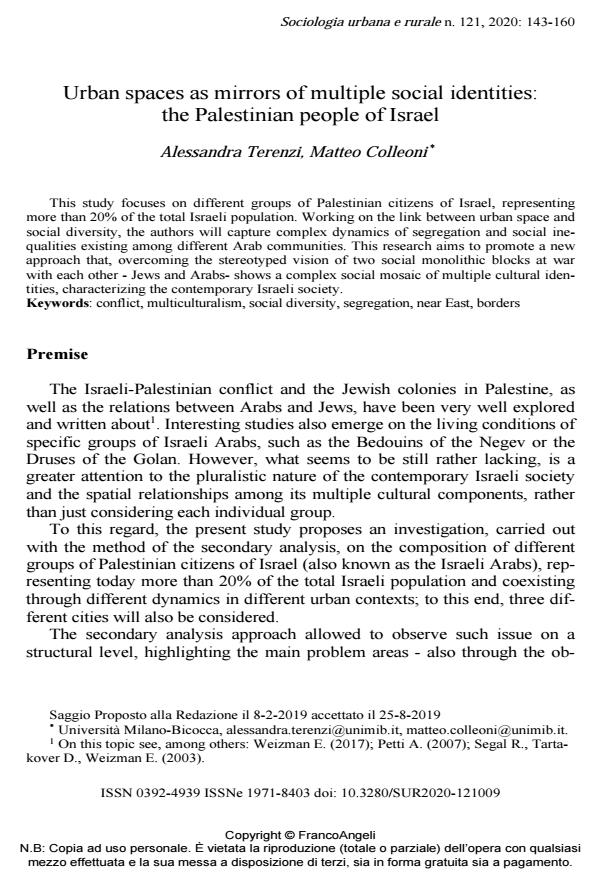Urban spaces as mirrors of multiple social identities: the Palestinian people of Israel
Titolo Rivista SOCIOLOGIA URBANA E RURALE
Autori/Curatori Alessandra Terenzi, Matteo Colleoni
Anno di pubblicazione 2020 Fascicolo 2020/121 Lingua Inglese
Numero pagine 17 P. 143-159 Dimensione file 188 KB
DOI 10.3280/SUR2020-121009
Il DOI è il codice a barre della proprietà intellettuale: per saperne di più
clicca qui
Qui sotto puoi vedere in anteprima la prima pagina di questo articolo.
Se questo articolo ti interessa, lo puoi acquistare (e scaricare in formato pdf) seguendo le facili indicazioni per acquistare il download credit. Acquista Download Credits per scaricare questo Articolo in formato PDF

FrancoAngeli è membro della Publishers International Linking Association, Inc (PILA)associazione indipendente e non profit per facilitare (attraverso i servizi tecnologici implementati da CrossRef.org) l’accesso degli studiosi ai contenuti digitali nelle pubblicazioni professionali e scientifiche
This study focuses on different groups of Palestinian citizens of Israel, representing more than 20% of the total Israeli population. Working on the link between urban space and social diversity, the authors will capture complex dynamics of segregation and social inequalities ex-isting among different Arab communities. This research aims to promote a new approach that, overcoming the stereotyped vision of two social monolithic blocks at war with each other - Jews and Arabs- shows a complex social mosaic of multiple cultural identities, characterizing the contemporary Israeli society.
Keywords:Conflict, multiculturalism, social diversity, segregation, near East, borders
- Lefebvre H. (1973). La rivoluzione urbana. Roma: Armando.
- Marcuse P. (1995). Not chaos, but walls: postmodernism and the partitioned city. In Watson S., Gibson K. (eds.). Postmodern cities and spaces. Oxford: Blackwell.
- Mela A. (2006). Sociologia delle città. Roma: Carocci.
- Petti A. (2007). Arcipelaghi e enclave: architettura dell’ordinamento spaziale contemporaneo. Milano: Mondadori.
- Remy J., Voyé L. (1981). Ville, ordre et violence. Paris: PUF.
- Rodotà S. (2017). I migranti. Le identità. Il razzismo. In Rodotà S. (a cura di). Profeta Rodotà. Gli interventi sull’Espresso 1990-2017. Roma: L’Espresso ebook.
- Said E. (2000). Invention, Memory, and Place. Critical Inquiry, 26: 175-192. DOI: 10.1086/448963
- Segal R., Tartakover D., Weizman E. (2003). A Civilian Occupation: The Politics of Israeli Architecture. New York: Verso Books.
- Sennet R. (2011). The Foreigner: Two Essays on Exile. New York: Notting Hill Editions.
- Shmueli D.F., Khamaisi R. (2015). Arab Communities of Israel and Their Urbanization. In Shmueli D.F., Khamaisi R. Israel’s Invisible Negev Bedouin: Issues of Land and Spatial Planning. Switzerland: Springer.
- Stefanizzi S. (2012). Il teatro della sicurezza. Attori, pratiche e rappresentazioni. Milano: et al.
- Terenzi A. (2016). Viaggio in Levante. Armature urbane, popoli e paesaggi. Boves: ArabaFenice.
- Therborn G. (2017). Cities of Power: The Urban, The National, The Popular, The Global. New York: Verso Books.
- Wacquant L. (2008). Ghettos and anti-ghettos: An anatomy of the new urban poverty. Thesis Eleven, 94(1): 113-118. DOI: 10.1177/0725513608093280
- Weizman E. (2017). Forensic Architecture: Violence at the Threshold of Detectability. New York: Zone Books.
- Yiftachel O., Yacobi H. (2003). Urban ethnocracy: ethnicization and the production of space in an Israeli ‘mixed city’. Environment and Planning D: Society and Space, 21: 673-693.
- Al-Haj M. (2005). Whither the Green Line? Trends in the Orientation of the Palestinians in Israel and the Territories. In Almagor R.C. (ed.). Israeli Democracy at the Crossroads. New York: Routledge.
- Arendt H. (1958). The human condition. Chicago: University Press.
- Azoury N. (1905). Le réveil de la Nation Arabe dans l’Asie turque. United States: Literary Licensing LLC.
- Barber B.R. (2016). If Mayors Ruled the World, Dysfunctional Nations, Rising Cities. New Haven: Yale University Press.
- Bauman Z. (2013). Violence in the age of uncertainty. In Crawford A. (ed.). Crime and Insecurity. London: Routledge.
- Bauman Z. (2009). Nascono sui confini le nuove identità. Corriere della Sera, 24 maggio.
- Beyhum N. (1997). De la ville ottomane chargée d’histoire à une ville du golfe partagée entre tribalisme et modernité. In Naciri M., Raymond A. (eds.). Sciences sociales et phénomenes urbains dans le monde arabe. Casablanca: Fondation du Roi Abdul Aziz al Saoud.
- Chiodelli F. (2016). Shaping Jerusalem: Spatial planning, politics and the conflict. London - New York: Routledge.
- Dal Lago A., Palidda S. (2010). Conflict, Security and the Reshaping of Society. The civilization of war. London - New York: Routledge.
- Derogy J., Gurgand J.N. (1974). Israel, la mort en face. Paris: Laffont.
- Ethington P. (1997). The intellectual construction of social distance: Toward a recovery of Georg Simmel’s social geometry. Cybergeo: European Journal of Geography. Epistemologie, Histoire de la Géographie, Didactique, 30.
- Foucault M. (2008). Le gouvernement de soi et des autres. Paris: Hautes Etudes Gallimard Seuil.
- Gazzola A. (2003). Trasformazioni urbane. Società e spazi di Genova. Napoli: Liguori.
- Goldscheider C. (2002). Israel’s changing society: Population, ethnicity, & development. Boulder: Westview Press.
- Khamaisi R. (2012). Transition from ruralism to urbanization: The case of Arab localities in Israel. Horizons in Geography, 79-80: 168-193.
- Khamaisi R. (2013). Housing Transformation within Urbanized Communities: The Arab Palestinians in Israel. Geography Research Forum, 33: 184-209.
- Kul Al-Arab K. (2000). Israeli Arabs Prefer Israel to Palestinian Authority. MEMRI The Middle East Media Research Institute, Special Dispatch 117. -- Testo disponibile al sito: https://www.memri.org/reports/israeli-arabs-prefer-israel-palestinian-authority.
- Stranieri a San Siro: l'abitare tra marginalità e riscossa Alessandra Terenzi, in SOCIOLOGIA URBANA E RURALE 129/2022 pp.121
DOI: 10.3280/SUR2022-129007
Alessandra Terenzi, Matteo Colleoni, Urban spaces as mirrors of multiple social identities: the Palestinian people of Israel in "SOCIOLOGIA URBANA E RURALE" 121/2020, pp 143-159, DOI: 10.3280/SUR2020-121009